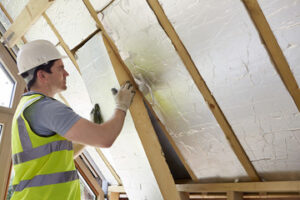Even the best-maintained hardwood floors eventually show signs of wear. Scratches, dents, and discoloration are a natural part of aging, but they can be improved with refinishing.

Water damage, on the other hand, can be more serious and may require replacement. Keeping an eye out for the following signs can help you know when it’s time to refinish your hardwood floors. Contact Hardwood Floor Refinishing Bergen County NJ for professional help.
Scratches along the surface of hardwood floors are a common occurrence that can be easily repaired with the right touch-up kit. However, deep gouges and scratches can require more extensive repair, and refinishing is the best solution. If a deep scratch exposes bare wood, it needs to be repaired using a stain that matches the floor. A wood filler that’s precolored should work well for this purpose, but you can also use a stain marker or blending pencil. Make sure the product you choose closely matches your floor color, and test it in an inconspicuous area first to ensure it blends properly.
A scratch that goes past the finish and into the wood will allow water to seep in and damage the hardwood. This is why it’s important to perform a water drop test on any suspect scratches. If you drop a few drops of water onto the flooring and they soak in within a few seconds, it’s time for refinishing.
In addition to water damage, refinishing is also necessary for hardwoods that are showing signs of discoloration. This can be due to normal aging, or it may be a result of water damage. Regardless, the discoloration will need to be refinished before it continues to worsen.
When wood starts to show signs of fading, it can affect the entire room and cause it to look darker. This is usually a sign that the stain has started to wear off and the wood beneath is starting to show through.
Refinishing can restore the natural beauty of your wood, but it’s a process that requires a significant amount of time. As a result, it’s typically done every 7-10 years. In some cases, refinishing can be done sooner than that, depending on the state of your hardwoods. A professional can help you determine if it’s time to refinish your wood floors. They can offer expert advice about the best products and techniques to use for a high-quality, long-lasting finish. They can also handle all the sanding and staining for you to get your floors back in excellent condition.
Water Damage
The longer water damage is left unattended, the more it can do to wood floors. In addition to causing visible warping of floorboards, the moisture can also lead to wood rot and other serious problems with subflooring and structural integrity of flooring.
Water-damaged hardwood is not only an eyesore, but it can also be a safety hazard for you and your family. Gaps and deep gashes can expose splinters, nails, and other hazards for your kids or pets to step on. A wet or rotting subfloor could also invite pests into your home, such as termites and other wood-boring insects. Refinishing your hardwood can protect the integrity of your flooring and help to limit pest intrusion.
Discolored or stained wood flooring can be a result of a variety of issues, including age and exposure to sunlight. But if you’ve noticed significant color changes or black spots on your hardwood, it’s time for a refinish. A professional can use a specialized sander to remove staining and other surface marks, leaving you with smooth, even hardwood surfaces again.
Wood is photosensitive, meaning that it can be affected by direct sunlight. This can cause fading or bleaching of the color of your hardwood, especially if they’re exposed to the sun without shade. A refinish can help restore your hardwood’s natural color and keep them looking bright and beautiful for years to come.
If you’ve already tried a wood cleaner and sanding, but your hardwood is still showing signs of water damage, it may be time to call in a professional to handle the refinishing. It’s important to hire a company with the right experience and equipment for the job, as well as a good track record of customer satisfaction. Ask potential contractors to explain their refinishing process and be sure you understand what to expect from the project, including how long it should take and whether or not you’ll need to vacate your home for a few days or move furniture in advance. A reputable flooring company will be transparent about the process and provide you with all of the information you need to make an informed decision.
Worn-Out Finish
Over time, even well-maintained hardwood floors will experience some normal wear and tear. This will usually manifest itself in the form of deep scratches, water damage or worn-out finish. If you notice that your floors are showing signs of this kind of wear, it is a good idea to consider having them refinished.
Scratches are a natural part of hardwood floor life and can be easily repaired with sanding and refinishing. However, if you find that your floors are getting scratched more easily than they used to or that the scratches are becoming deeper and cutting through the polyurethane coating, then it is likely time for refinishing.
Water damage can also be a sign that it’s time to have your floors refinished. While a good stain and sealant will keep spills from soaking into the wood, if your home has experienced some major plumbing problems or flooding then this can be a serious problem that needs to be dealt with immediately.
Another sign that your hardwood floors are in need of refinishing is if the finish has worn away to the point that it shows white lines. This is a known issue that can be caused by a variety of things, including environmental factors like humidity and humidity fluctuations, improper cleaning products and the type of finish used on the floors.
This condition is also referred to as “fisheye”, and can be a sign of moisture damage, which is why it’s important to have your floors refinished as soon as possible.
Keeping your hardwood floors looking their best is one of the easiest ways to increase the value of your home, and it’s something that any homeowner can do with regular maintenance and refinishing. Whether you’re interested in changing up the color of your floors or simply want to breathe new life into them, refinishing is the perfect solution. Before you get started, remove all furniture and vacuum thoroughly to remove any dust that may have collected over the years. Ensure that you cover all doorways and seal any electrical sockets or other crevices to prevent sanding dust from escaping the room.
Faded Color
Although a little scratching can add character to hardwood floors and may be re-stained to cover small marks, significant, widespread fading is a sign that the protective finish has worn down. Refinishing the wood will protect against further damage and keep the color vibrant.
Floors that receive a lot of direct sunlight can become discolored over time due to UV rays. This is not as much of an issue with darker floors than it is with light-colored ones, but if the overall look of your home is marred by sun-bleached spots that are noticeable even when covered with furniture or rugs, it is definitely time to refinish.
While it is impossible to completely avoid fading over the long term, refinishing can slow the process and minimize the amount of time your floors need to recover their original color. You can also take steps to prevent fading in the future by closing curtains or blinds during the hottest parts of the day, and using a special window film that blocks harmful UV rays. Also, rearranging the position of rugs regularly can help even out fading and staining, as moving them across the grain helps minimize the cross-grain fading line that often shows up on hardwoods.
Refinishing can be a time-consuming and costly project, but it is well worth it to restore the beauty of your hardwood floors. If you are ready to make the switch to a new hardwood floor finish, contact your local refinishing professionals. They can give you an estimate and schedule a time to complete the job. Just be sure to clear out the space and prepare your home for a few days without furniture while the work is being done. If you try refinishing yourself, it is important to note that DIY refinishing may void your manufacturer warranty. Hiring a professional will ensure that your hardwoods are finished properly and protected from further damage. They can also recommend a suitable stain and finish for your floors to achieve the desired effect. The right product will not only protect your hardwoods, but it can enhance the beauty of your home and increase its value.


